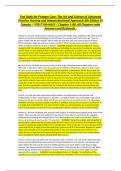Exam (elaborations)
Primary Care: The Art and Science of Advanced Practice Nursing and Interprofessional Approach 6th Edition M Dunphy / 9781719644655 / Chapter 1-88 ,All Chapters with Answers and Rationals .
- Course
- Institution
- Book
Primary Care: The Art and Science of Advanced Practice Nursing and Interprofessional Approach 6th Edition M Dunphy / 9781719644655 / Chapter 1-88 ,All Chapters with Answers and Rationals .
[Show more]



